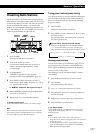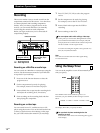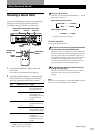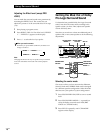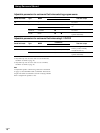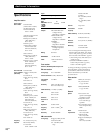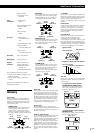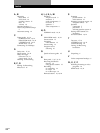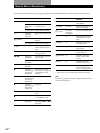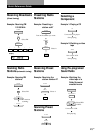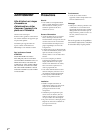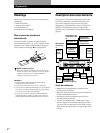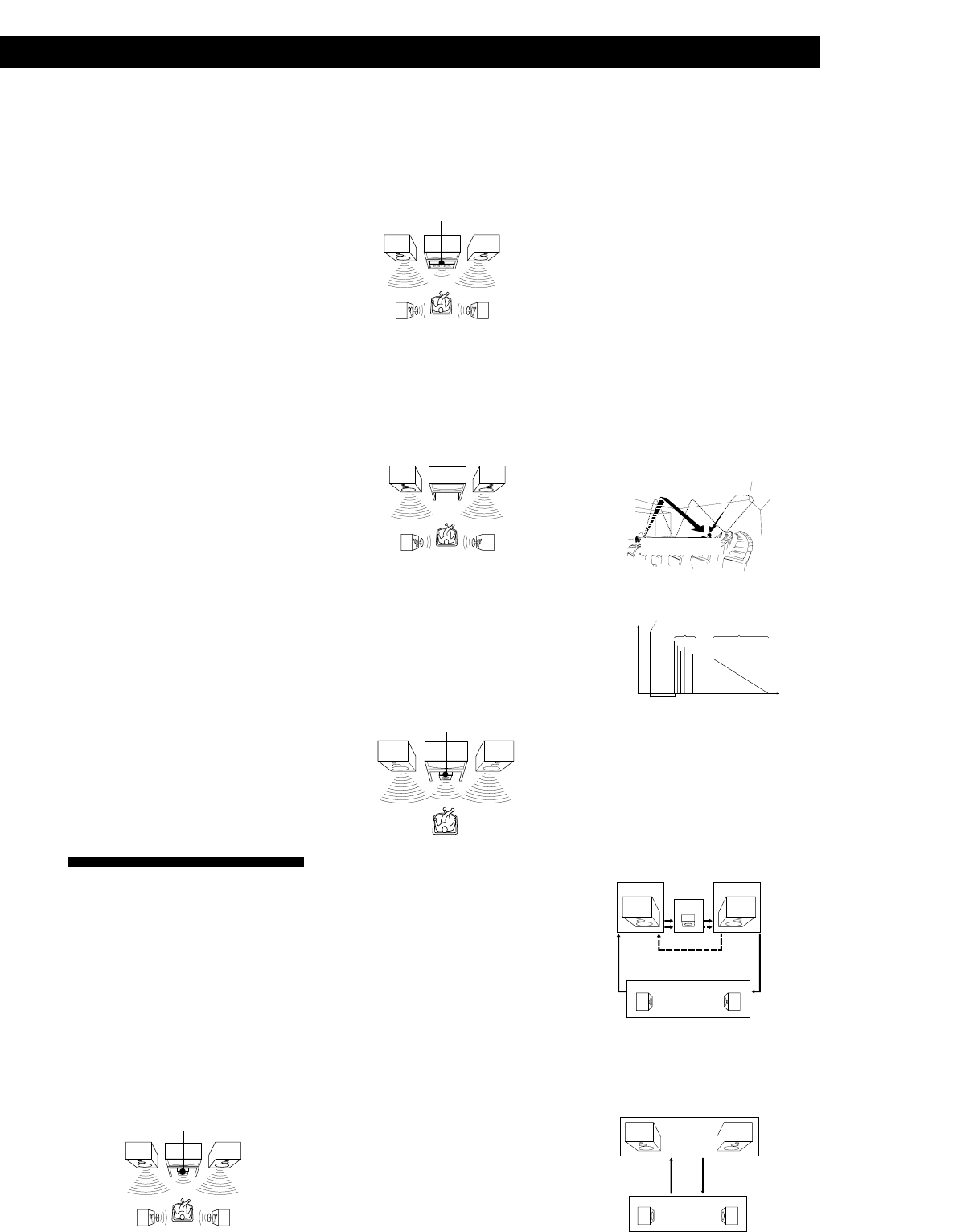
21
US
Additional Information
5.1 CH/DVD
These jacks are used to input decoded Dolby
Digital (AC-3) audio signals, allowing you to
enjoy 5.1 channel surround sound. Use these
jacks to connect a Dolby Digital (AC-3)
decoder or a DVD player with a built-in AC-3
decoder.
Preset station
A radio broadcasting station that is stored in
memory of the receiver. Once you “preset”
stations, you no longer have to tune in the
stations. Each preset station is assigned its
own preset number, which lets you tune
them in quickly.
Surround sound
Sound that consists of three elements: direct
sound, early reflected sound (early
reflections) and reverberative sound
(reverberation). The acoustics where you hear
the sound affect the way these three sound
elements are heard. These sound elements are
combined in such a way that you can actually
feel the size and the type of a concert hall.
Power
consumption
AC outlets
Dimensions
Mass (Approx.)
Supplied
accessories
Other countries:
120/220/240 V AC,
50/60 Hz
Canada model:
325 VA
Australia, Singapore and
Malaysia models:
235 W
Other countries:
245 W
Canada model:
1 switched 120 W/1A
max
Australia, Singapore and
Malaysia models:
1 switched 100 W max
Other coutries:
1 switched 100 W max
430 x 144 x 306 mm
8.8 kg (19 lb 6 oz)
FM wire antenna (1)
AM loop antenna (1)
Remote commander
(remote) (1)
Size AA (R6) batteries (2)
The specification measured is under
• 230 AC 50 Hz condition (Singapore and
Malaysia models)
• 240 AC 50 Hz condition (Australia
model).
Design and specifications are subject to
change without notice.
Glossary
Center mode
Setting of speakers to enhance Dolby Pro
Logic Surround mode. To obtain the best
possible surround sound, select one of the
following four center modes according to
your speaker system.
• NORMAL mode
Select NORMAL mode if you have front
and rear speakers and a small center
speaker. Since a small speaker cannot
produce enough bass, the bass sound of
the center channel is output from the front
speakers.
Center
speaker
Rear
speaker (R)
Rear
speaker (L)
Front
speaker (R)
Front
speaker (L)
• WIDE mode
Select WIDE mode if you have front and
rear speakers and a large center speaker.
With the WIDE mode, you can take full
advantage of Dolby Surround sound.
• PHANTOM mode
Select PHANTOM mode if you have front
and rear speakers but no center speaker.
The sound of the center channel is output
from the front speakers.
• 3 STEREO mode
Select 3 STEREO mode if you have front
and center speakers but no rear speaker.
The sound of the rear channel is output
from the front speakers to let you
experience some of the surround sound
without using rear speakers.
Delay time
Time lag between the surround sound output
from front speakers and rear speakers. By
adjusting the delay time of the rear speakers,
you can obtain the feeling of presence. Make
the delay time longer when you have placed
the rear speakers in a small room or close to
your listening position, and make it shorter
when you have placed them in a large room
or apart from your listening position.
Direct tuning
Tuning method to let you directly enter a
station’s frequency using the numeric buttons.
Use this method if you know the frequency of
the station you want.
Dolby Pro Logic Surround
As one method of decoding Dolby Surround,
Dolby Pro Logic Surround produces four
channels from two channel sound. Compared
with the former Dolby Surround system,
Dolby Pro Logic Surround reproduces left-to
right panning more naturally and localizes
sounds more precisely. To take full advantage
of Dolby Pro Logic Surround, you should
have one pair of rear speakers and a center
speaker. The rear speakers output monaural
sound.
Center
speaker
Rear
speaker (L)
Front
speaker (L)
Rear
speaker (R)
Front
speaker (R)
Front
speaker (L)
Rear
speaker (L)
Front
speaker (R)
Rear
speaker (R)
Center
speaker
Front
speaker (R)
Front
speaker (L)
Reverberation
Early reflections
• Types of sound
• Transition of sound from rear speakers
Test tone
Signal given out by the receiver for adjusting
the speaker volume. The test tone will come
out as follows:
• In a system with a center speaker
(NORMAL/WIDE/3 STEREO modes)
The test tone is output from the front L
(left), center, front R (right), and rear
speakers in succession.
• In a system without a center speaker
(PHANTOM mode)
The test tone is output from the front and
the rear speakers alternately.
Direct sound
Direct sound
Early
reflections
Reverberation
Level
Early reflection time
Time
3 STEREO
Center
Front (R)
Front (L)
NORMAL/WIDE
Rear (L, R)
Rear (L, R)
PHANTOM
Front (L, R)



